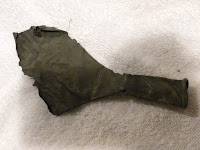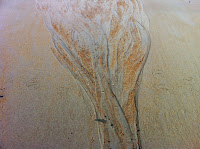And all of 30 seconds into the day, I could tell some weirdness was afoot.
I've seen the ocean pull together these interesting mounds of rock & cobble down in the southern part of my walk before. But never up on the northern end. It's always a thrill, witnessing nature cull & arrange perfect piles of stone. Only to blow them all apart with the next tide.
Along with the stone was a colorful array of bone, shell, deep/coldwater coral shards...
And plastic cats?
This was an amazing day. Not just for how much debris washed up, but for where it washed up. Here's Zone N:
46 finds:
- Building materials: 19 (9 asphalt chunks, 6 brick, 4 tile)
- Foam/Styrofoam: 1
- Fishing misc.: 4 (trap vinyl coating scraps)
- Food-related plastic: 2 (wrappers)
- Food-related metal/glass: 8 (2 can scraps, 6 sea glass)
- Non-food/unknown plastics: 8 (3 plastic hairbands, button, toy cat, vinyl scrap, 2 strapping)
- Cigarette filters/plastics: 0
- Paper/wood: 2 (paper scrap, wood firecracker stick)
- Misc./unique: 2 (glass bead, leather scrap)
189 finds:
- Building materials: 14 (4 asphalt, 3 brick, 3 shingles, 3 wood stakes, plywood chip)
- Foam/Styrofoam: 1
- Fishing misc.: 72 (4 rope scraps, 30 vinyl trap scraps, 34 claw bands!, shotgun shell, 3 trap bumpers)
- Food-related plastic: 13 (2 bottlecap liners, cup top, cup scrap, 3 gum, 3 silverware, 3 wrappers)
- Food-related metal/glass: 11 (4 bottle caps, foil, 6 seaglass)
- Non-food/unknown plastics: 59 (balloon, 3 hairbands, bandaid, 5 plastic wrap, 4 tape scraps, 4 strapping, 7 vinyl shards, bow, firecracker, clothes tag, 14 scraps >1", 17 scraps <1")
- Cigarette filters/plastics: 9 (8 filters, 1 filter tip)
- Paper/wood: 1 (paper air filter)
- Misc./unique: 9 (crayon tip, aluminum scrap, 5 fabric pieces, 2 gloves)
 |
| Ancient & grotty lobster claw bands |
 |
| Fish-nibbled balloon |
 |
| Truth in advertising |
Minus a couple local food wrappers, it all sinks. Every piece that washed up this week is denser than seawater. It all once littered the seafloor. From there, currents & tides dragged it along rock, over silt, through weed. Until finally hurling the bits up onshore, along with shell & bone & stone. Crazy. Especially since Weather Underground's historical data for the week shows offshore breezes, the tide chart shows weak tides, and the local NOAA buoy also shows winds & surface currents moving offshore. What's happening on the ocean bottom often bears no relationship to what's happening just a few meters above.
One for the books, that's for sure. (And maybe a little background for why Nov. 21's walk put me in a more thankful frame of mind.) My takeaway? Whether the discarded plastics of our modern world float, or sink, they still pollute. And very rarely do any of them ever go "away."





























